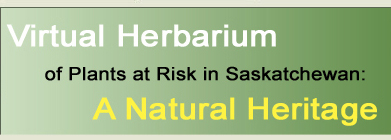
|

|

|

|

|

|

|
|
|
|
|
|
| Pellaea glabella ssp. occidentalis (E.Nels.) Windham | Species Image Gallery (opens in a new window) |
||||||||
| TAXONOMY | |||||||||
| Family: | Pteridaceae | ||||||||
| Genus: | Pellaea | ||||||||
| Species Synonyms: | Pellaea glabella var. nana (L.C.
Rich.) Cody Pellaea glabella var. occidentalis (E. Nels.) Butters Pellaea occidentalis (E. Nels) Rydb. |
||||||||
| Common Names: | smooth cliffbrake | ||||||||
| DISTRIBUTION | |||||||||
| Canada: | southwest Mackenzie District – northern Saskatchewan - southern Manitoba | ||||||||
| Saskatchewan: | northern to southeastern Saskatchewan; Cluff Lake, Deschambault Lake – Amisk Lake, Beaver River – Big Muddy Lake, Roche Percee | ||||||||
| Ecoregion: | Mixed Grassland, Moist Mixed Grassland, Churchill River Upland, Athabasca Plain | ||||||||
| HABITAT | |||||||||
| Saskatchewan: | limestone cliffs and outcrops | ||||||||
| Associated species: | Woodsia glabella | ||||||||
| RARITY STATUS | |||||||||
| Provincial
Status According to Harms (2003): |
Threatened |
||||||||
| Nature Conservancy Status: | G5T4 S2 |
||||||||
| Saskatchewan
Species at Risk Status: |
None |
||||||||
| COSEWIC Status: | None |
||||||||
| Pellaea glabella ssp. occidentalis is threatened because it is rare or uncommon in Saskatchewan. This species occurs in a wide range in Saskatchewan but in a small number of localities. Some local populations are small and some larger. No immediate threats known but may occur in the future. | |||||||||
| SPECIES DESCRIPTION | |||||||||
| Height: | 2 – 15 cm | ||||||||
| Roots: | rhizomes compact, ascending; scales linear-subulate, reddish-brown, concolorous, margin sinuous, entire to denticulate | ||||||||
| Fronds: | monomorphic, caespitose; crosiers sparsely villous; stipe 1 – 10 cm long, slender, brown, lustrous, may have prominent articulation lines near the base; blade linear to ovate, 1 – 2-pinnate, 1 – 10 cm long, glaucous; rachis brown throughout, nearly glabrous | ||||||||
| Pinnae: | ascending or spreading, decurrent on rachis, lower pinnae simple to pinnate with 3 – 7 lobes, sessile or short-petiolate, upper pinnae simple; ultimate segments 5 – 20 mm long, lanceolate, leathery to herbaceous, glabrous, margins recurved on fertile segments, borders whitish | ||||||||
| Sori: | marginal, covered by false indusium | ||||||||
| Sporangium: | long-stalked, containing 64 spores | ||||||||
| |||||||||